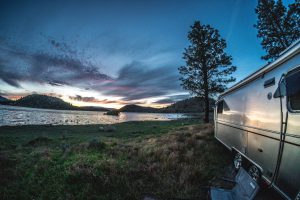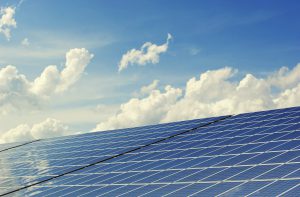
One of the greatest things about having an RV is the ability to get in on dry camping or boondocking. Unfortunately, many RVers don’t even know this opportunity exists and therefore miss out entirely.
If RV dry camping is something you’d like to try but you’re not sure how to get started, this is the article for you. Here we will address common boondocking questions and let you in on our favorite dry camping tips.

What is Dry Camping?
Some of you may be wondering, “What does dry camping mean?” Basically, this is a term that means camping without any hookups whatsoever. Dry camping, also known as boondocking, can be done on private property (with permission, of course), on government-owned lands, or anywhere else you can find a place to park legally. In most cases this is free camping, so it’s a great option for those on a tight budget.
Some people also refer to staying overnight in a parking lot as dry camping, but there’s a lot of debate over whether or not this qualifies.
Dry Camping Tips
The next thing that most people want to know is how to dry camp. Our number one tip is to dip your toes in first and build up to longer trips as you find your own boondocking groove.
Below we’ve made a list of our other tips and tricks:
Water Tips
Without water or sewer hookups, you will want to learn some ways to carry extra water, how to conserve this precious resource, and ways to get rid of the waste water properly.
Get a bladder — A water bladder such as this one is a great way to carry extra water. Use it to refill your fresh water tank when it runs dry.
Change your shower head and faucets — A low-flow shower head like this one, as well as low-flow faucets, can save a lot of water.
Reuse shower or dish water — Instead of using fresh water to flush your toilet, collect your dish and shower water and use it when it’s time to flush. This saves fresh water and makes more room in your gray tank when needed.
Shower less — Of course, showering less helps too. Dry shampoo and wipes such as these help a lot.
Invest in a blue boy — A blue boy can hold onto waste water when your tanks get full and you’re unable to make it to a dump station. It’s also easier to transport a blue boy to and from a dump station than it is to move your entire rig every time you need to dump.
Electricity Tips
Beside water, you’ll also need to find ways to conserve and create electricity when boondocking. Obviously, things like running the air conditioner or a hair dryer are typically out of the question without electric hookups, and even things like lights and vent fans can drain a battery faster than you might imagine.
Change to LED lighting — Changing all of your lights to LED will help save electricity.
Get a solar panel — A portable solar panel is relatively inexpensive and can be extremely helpful when it comes to keeping your RV battery topped up.
Invest in more batteries — Of course, having more batteries to work with will also mean more electricity to use when off-grid. Combine these with multiple solar panels for best results.
Use a generator — Most motorhomes come with a camping generator. Meanwhile, those using travel trailers will need to invest in a separate one. Either way, using a generator is a great way to top up your battery and even run the A/C on really hot afternoons. Just be aware that generators shouldn’t be run constantly, or at night out of respect for other campers.
Where to Find Boondocking Locations
Once you have your boondocking RV outfitted and these tips under your belt, you might be left asking yourself, “How do I find free camping near me?”
One of the best options is to check out the Free Campsites page. Campendium is another great resource for finding such spots. Some other options which give you access to dry camping locations on private property are the paid membership organizations Boondockers Welcome and Harvest Hosts.
This post may contain affiliate links.


